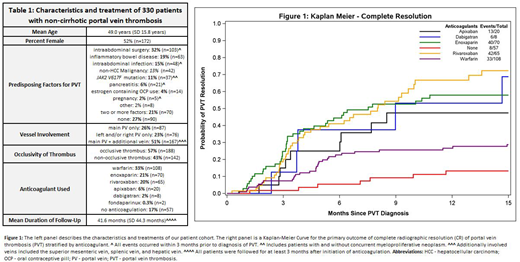Introduction:
Anticoagulation (AC) is the standard therapy for non-cirrhotic portal vein thrombosis (PVT). Professional society guidelines and expert opinions currently favor the use of vitamin K antagonists (VKAs) or low molecular weight heparins (LMWHs) for the treatment of PVT. Routine use of direct oral anticoagulants (DOACs) in PVT has often been met with concern due to a lack of data. We investigated the efficacy and safety of DOACs for the treatment of non-cirrhotic PVT, and compared them to standard therapies (VKAs and LMWHs).
Methods:
We conducted a retrospective review of patients treated at a tertiary care center. Patients were identified who had a documented PVT with or without concurrent thrombosis in additional splanchnic vessels, followed between 1/1/2000 and 2/1/2019. Patients were excluded if they had cirrhosis or tumor thrombus, received thrombectomy, lacked baseline imaging of PVT at diagnosis, or lacked subsequent follow-up imaging at least 3 months following diagnosis. The initial long-term AC used in each instance was recorded and formed the basis for comparison. In many cases intravenous heparin was used as initial short-term AC, and in these instances the first long-term AC transitioned to thereafter was regarded. The primary outcome was complete radiographic resolution of PVT (established on follow-up imaging). Secondary outcomes included recanalization (with or without complete resolution) of occlusive PVT, development of chronic portal hypertensive symptoms (cPHS, defined as new or worsening esophageal varices demonstrated on EGD, or new or worsening ascites requiring diuretic medications), and major (WHO grade 3 or 4) bleeding. Hazard ratios for each outcome were calculated via multivariable (MV) analysis.
Results:
A total of 330 patients were included. Their characteristics and treatments are described in Table 1. There were a variety of predisposing factors for PVT. Of note 27% (n=90) had no evident predisposing factor. A wide variety of ACs were used. Although the most commonly used ACs were the standard therapies warfarin (n=108) and enoxaparin (n=70), many patients received DOACs (n=93), most often rivaroxaban (n=65).
Figure 1 shows the primary outcome of complete radiographic resolution (CR) stratified by AC. The CR rate was significantly higher among patients who received AC (49%) than those who did not (14%) (p <.0001). Among anticoagulated patients, those who received DOACs had the highest rates of CR (dabigatran 6/8=75%, apixaban 13/20=65%, rivaroxaban 42/65=65%). Enoxaparin had a CR rate not significantly different from the DOACs (40/70=57%). Warfarin, with a CR rate of 31% (33/108), was the only AC inferior to others on MV analysis (HR for CR warfarin : rivaroxaban 0.36 (0.22 - 0.57, p<.0001)).
There were similar findings when comparing rates of recanalization of occlusive PVT (no AC 2/29= 7%, any AC 71/159=45%, dabigatran 4/5=80%, rivaroxaban 22/35=63%, apixaban 7/13 =54%, enoxaparin 16/36=44%, warfarin 21/68=31%). On MV analysis warfarin was inferior to each DOAC with respect to recanalization of occlusive PVT. Development of cPHS occurred in 30/57 (52%) of patients who received no AC compared with 52/273 (19%) of those who received AC (p=.0093). Although there was a trend toward less cPHS among those receiving rivaroxaban compared with warfarin (rivaroxaban 5/65=8%, enoxaparin 13/70=19%, warfarin 31/108=29%), this difference was not statistically significant on MV analysis. Major bleeding rates were not significantly different with or without AC, or among the various ACs.
Among predisposing factors for PVT, patients harboring JAK2V617F had notably poor outcomes compared to those with other known predisposing factor (CR 8% vs 55% p=.0016; recanalization 16% vs 49% p=.0036; development of cPHS 49% vs 17% p=.5492). The 90 patients with no evident predisposing factor also demonstrated worse outcomes compared to those with evident non-JAK2 predisposing factors (CR 31% vs 55% p= .0152; recanalization 33% vs 49% p=.0896; development of cPHS 32% vs 17% p=.7406).
Conclusions:
DOACs are safe and effective for treatment of non-cirrhotic PVT. Use of warfarin is associated with inferior outcomes among non-cirrhotic PVT patients when compared with other forms of AC. Patients harboring JAK2V617, and to a lesser extent those without a clear predisposing factor for PVT, have inferior outcomes compared with other non-cirrhotic PVT patients.
Mascarenhas:Incyte: Consultancy, Membership on an entity's Board of Directors or advisory committees, Research Funding; Novartis: Research Funding; Roche: Consultancy, Research Funding; Merck: Research Funding; Celgene: Consultancy, Membership on an entity's Board of Directors or advisory committees, Research Funding; CTI Biopharma: Consultancy, Membership on an entity's Board of Directors or advisory committees, Research Funding; Janssen: Research Funding; Promedior: Research Funding; Merus: Research Funding; Pharmaessentia: Consultancy, Membership on an entity's Board of Directors or advisory committees.
This abstract will discuss the use of direct oral anticoagulants including rivaroxaban, apixaban, and dabigatran, for anticoagulation of portal and other splanchnic vein thrombosis.
Author notes
Asterisk with author names denotes non-ASH members.


This feature is available to Subscribers Only
Sign In or Create an Account Close Modal